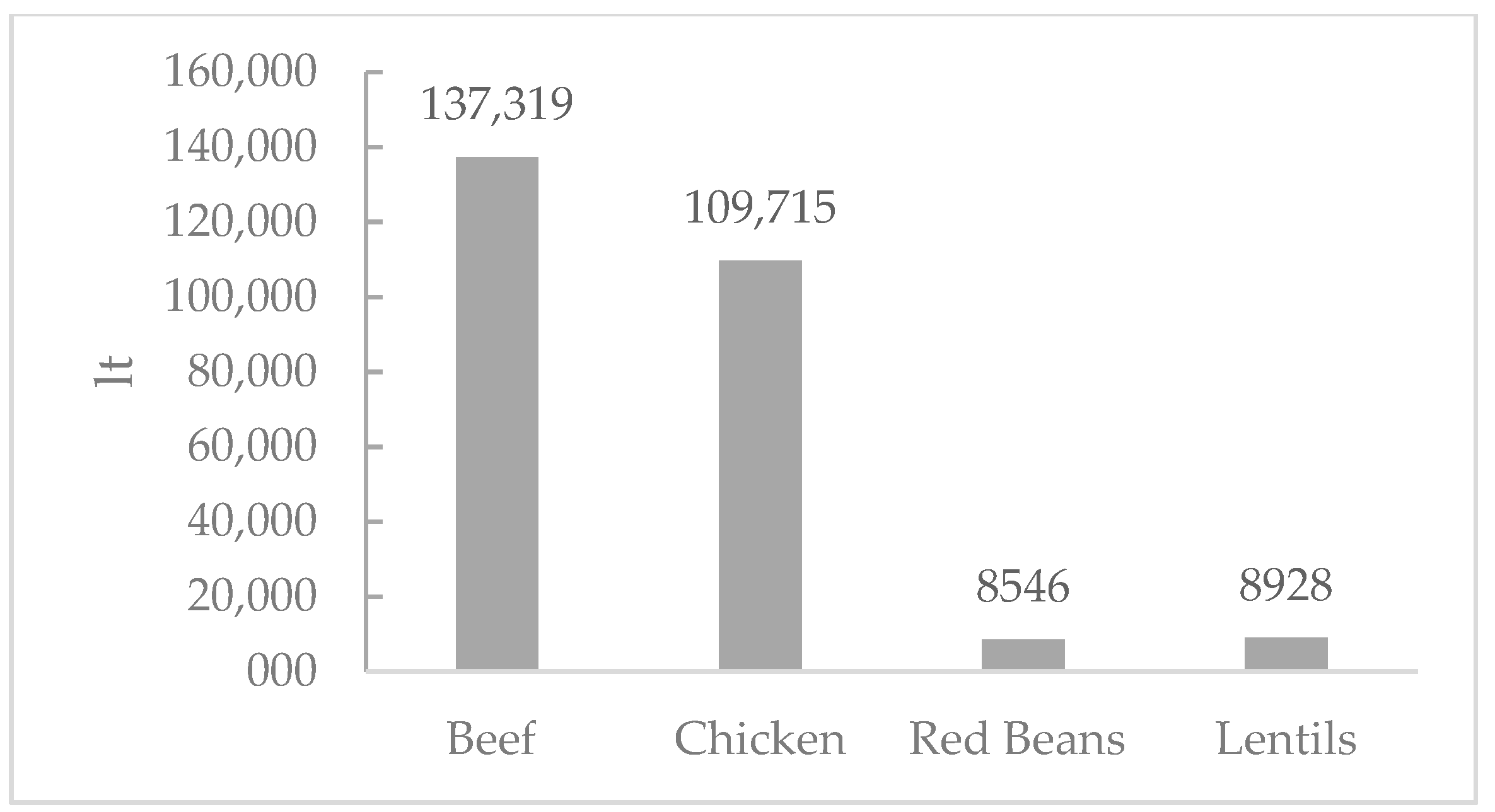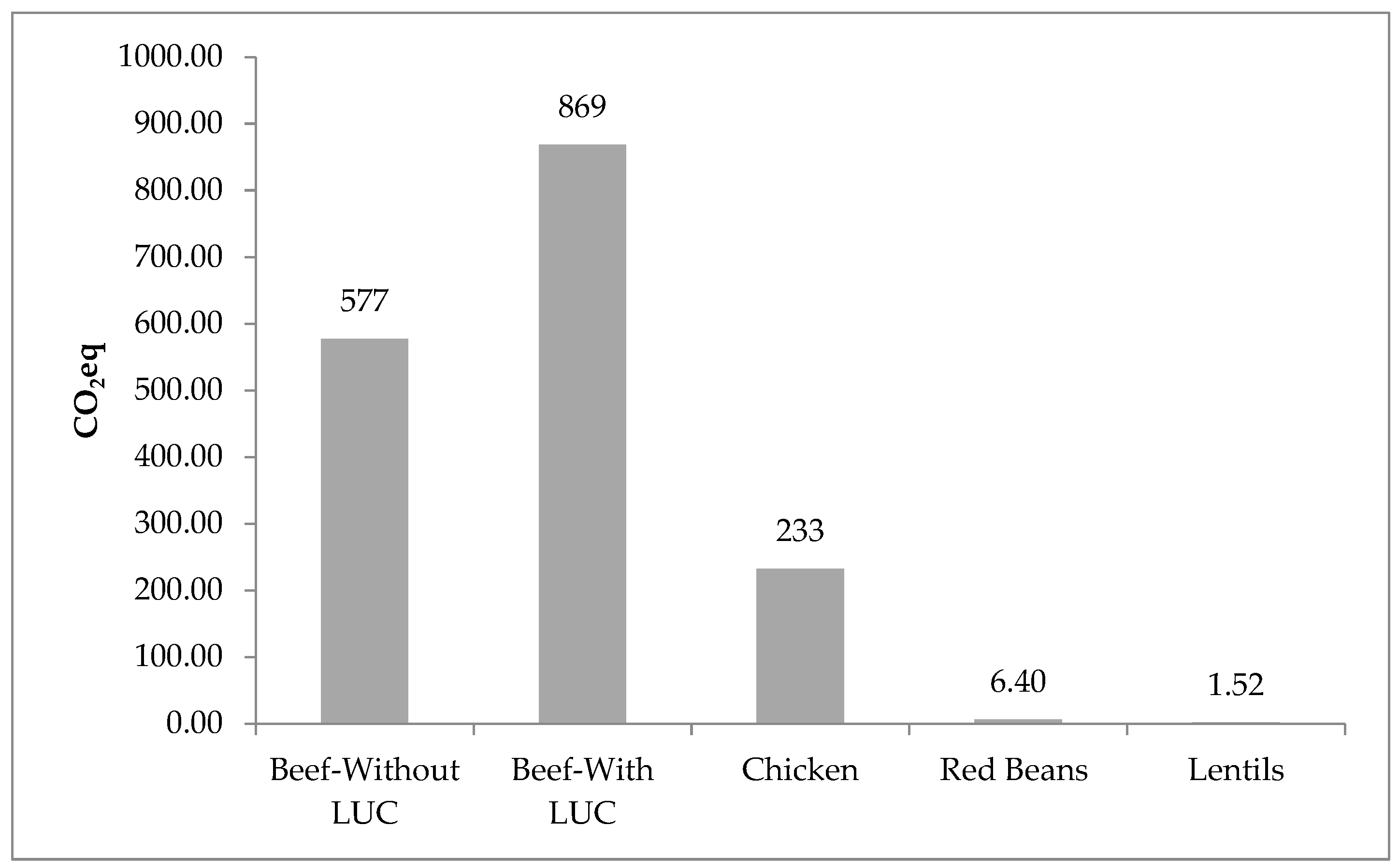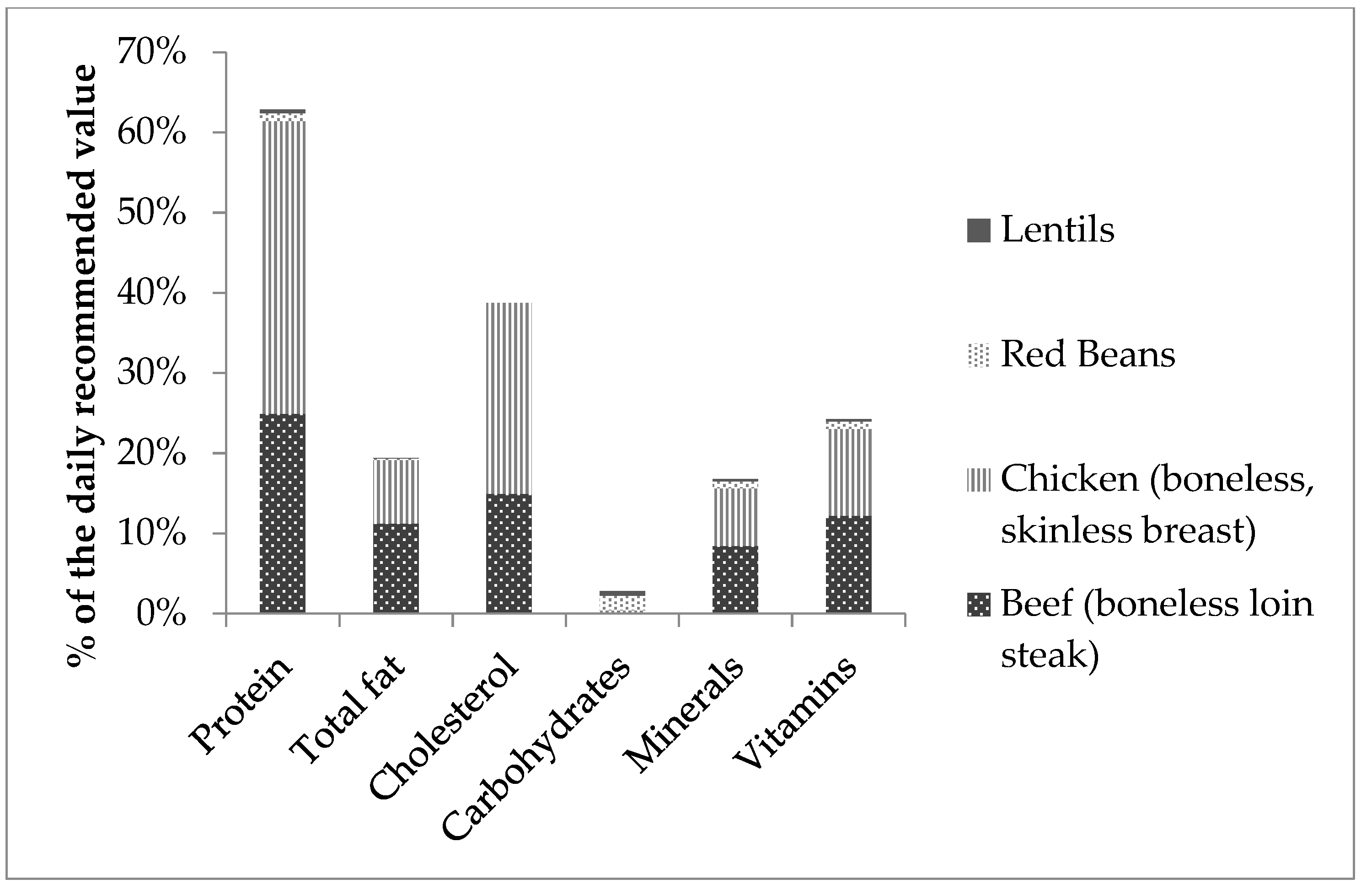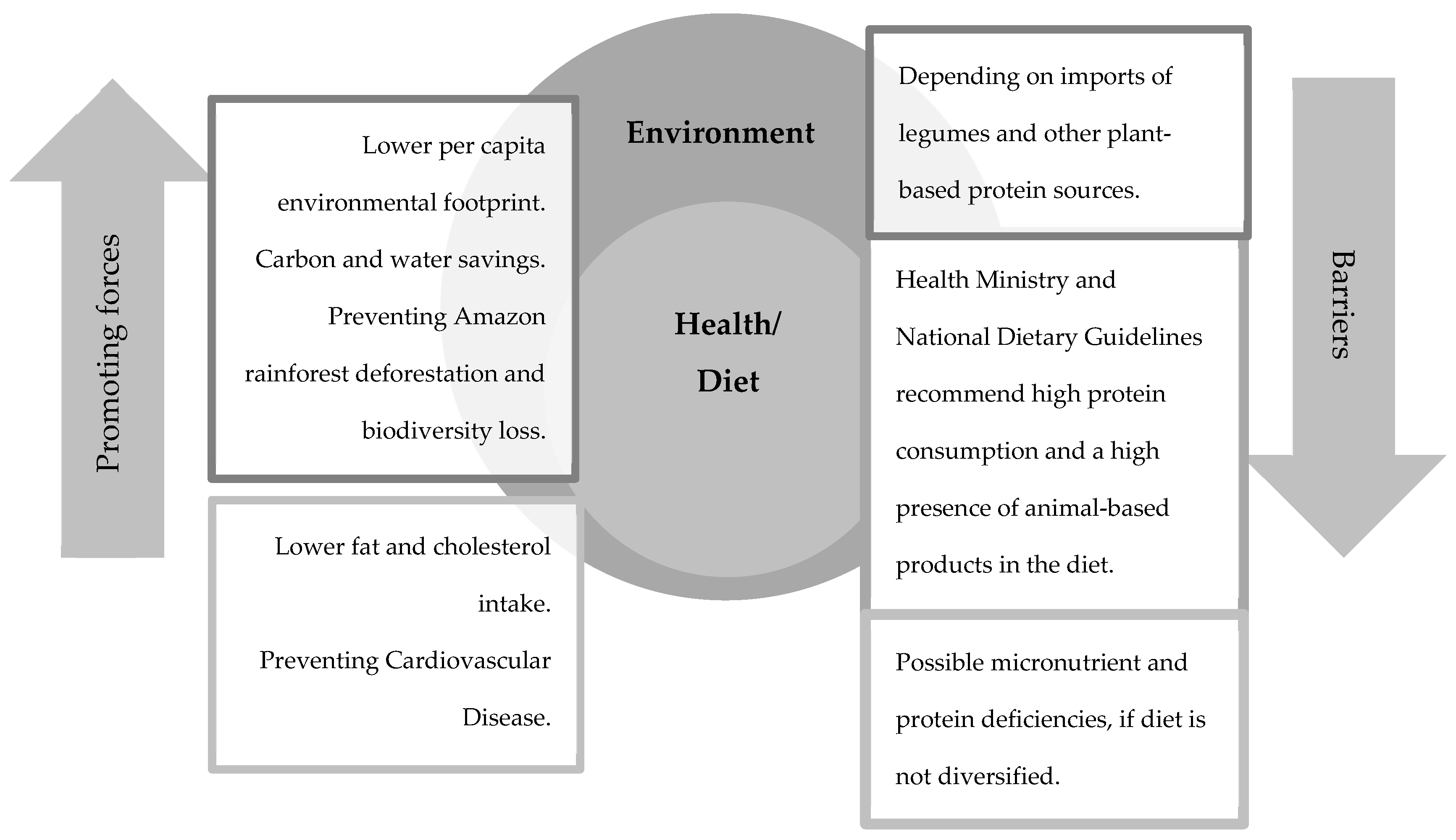Sustainable Diets and Meat Consumption Reduction in Emerging Economies: Evidence from Colombia
Abstract
1. Introduction
2. Materials and Methods
2.1. Methods for the Environmental Dimension
2.2. Methods for the Health/Nutrition Dimension
Statistical Analysis
3. Results
3.1. Environmental Dimension
3.1.1. Water Footprint
3.1.2. Carbon Footprint
3.2. Health/Nutrition Dimension
4. Discussion
5. Conclusions
Author Contributions
Funding
Acknowledgments
Conflicts of Interest
References
- Dixon, J.; Isaacs, B. Why Sustainable and “Nutritionally Correct” food is not on the agenda: Western Sydney, the Moral Arts of Everyday Life and Public Policy. Food Policy 2013, 43, 67–76. [Google Scholar] [CrossRef]
- Wyne, S.; Nicholas, K.A. The climate mitigation gap: Education and government recommendations miss the most effective individual actions. Environ. Res. Lett. 2017, 12, 1–7. [Google Scholar] [CrossRef]
- Vermeir, I.; Verbeke, W. Sustainable Food Consumption: Exploring the Consumer “Attitude—Behavioral Intention” Gap. J. Agric. Environ. Ethics 2006, 19, 169–194. [Google Scholar] [CrossRef]
- Mäkiniemi, J.P.; Vainio, A. Barriers to climate-friendly food choices among young adults in Finland. Appetite 2014, 74, 12–19. [Google Scholar] [CrossRef]
- Myers, S.; Bernstein, A. The coming health crisis: Indirect health effects of global climate change. F1000 Rep. Biol. 2011, 3, 1–5. [Google Scholar] [CrossRef]
- Paarlberg, R. Food Politics: What Everyone Needs to Know, 2nd ed.; Oxford University Press: New York, NY, USA, 2013; pp. 137–142. [Google Scholar]
- Godfray, C.J.; Aveyard, P.; Garnett, T.; Hall, J.W.; Key, T.J.; Lorimer, J.; Pierrehumbert, R.T.; Scarborough, P.; Springmann, M.; Jebb, S.A. Meat consumption, health, and the environment. Science 2018, 361, 1–10. [Google Scholar] [CrossRef]
- FAO. Livestock’s Long Shadow. Environmental Issues and Options. Available online: http://www.fao.org/3/a-a0701e.pdf (accessed on 16 September 2016).
- Clonan, A.; Roberts, K.; Holdsworth, M. Socioeconomic and demographic drivers of red and processed meat consumption: Implications for health and environmental sustainability. Proc. Nutr. Soc. 2016, 75, 367–373. [Google Scholar] [CrossRef]
- McAlpine, C.; Etter, A.; Fearnside, P.; Seabrook, L.; Laurance, W. Increasing world consumption of beef as a driver of regional and global change: A call policy action based on evidence from Queensland (Australia), Colombia and Brazil. Glob. Environ. Chang. 2009, 19, 21–33. [Google Scholar] [CrossRef]
- MinSalud. Estrategia Nacional Para La Prevención Y Control De Las Deficiencias De Micronutrientes En Colombia 2014–2021. Available online: https://www.minsalud.gov.co/sites/rid/Lists/BibliotecaDigital/RIDE/VS/PP/SNA/Estrategia-nacional-prevencion-control-deficiencia-micronutrientes.pdf (accessed on 28 November 2016).
- Johnston, J.; Fanzo, J.; Cogill, B. Understanding Sustainable Diets: A Descriptive Analysis of the Determinants and Processes That Influence Diets and Their Impact on Health, Food Security, and Environmental Sustainability. Adv. Nutr. 2014, 5, 418–429. [Google Scholar] [CrossRef]
- Lang, T. Sustainable Diets: Another hurdle or a better food future? Development 2015, 57, 240–256. [Google Scholar] [CrossRef]
- Paarlberg, R. Governing the dietary transition: Linking agriculture, nutrition and health. In Proceedings of the Leveraging Agriculture for Improving Nutrition and Health, New Dheli, India, 10–12 February 2011. [Google Scholar]
- UNEP. The Critical Role of Global Food Consumption Patterns in Achieving Sustainable Food Systems and Food for All. A UNEP Discussion Paper. Available online: http://www.unep.org/resourceefficiency/Portals/24147/scp/agri-food/pdf/Role_of_Global_Food_Consumption_Patterns_A_UNEP_Discussion_Paper.pdf. (accessed on 28 November 2016).
- IPCC. IPCC Fourth Assessment Report. Food, Fiber and Forest Products. Available online: http://www.ipcc.ch/pdf/assessment-report/ar4/wg2/ar4-wg2-chapter5.pdf. (accessed on 28 November 2016).
- World Watch Institute. Meat. Now It’s not Personal! World Watch: Washington, DC, USA, 2004; pp. 12–20. [Google Scholar]
- Machovina, B.; Feeley, K.; Ripple, W. Biodiversity conservation: The key is reducing meat consumption. Sci. Total Environ. 2015, 536, 419–431. [Google Scholar] [CrossRef] [PubMed]
- Micha, R.; Wallace, S.; Mozaffarian, D. Red and Processed Meat Consumption and Risk of Incident Coronary Heart Disease, Stroke, and Diabetes Mellitus. Circulation 2010, 121, 2271–2283. [Google Scholar] [CrossRef] [PubMed]
- Rohrmann, S.; Overvad, K.; Bueno-de-Mesquita, H.; Jakobsen, M.; Tjønneland, A.; Nailler, L.; Boutron-Ruault, M.C.; Clavel-Chapelon, F.; Krogh, V.; Palli, D.; et al. Meat consumption and mortality—results from the European Prospective Investigation into Cancer and Nutrition. BMC Med. 2013, 11, 1–12. [Google Scholar] [CrossRef] [PubMed]
- IARC. Q&A on the Carcinogenicity of the Consumption of Red Meat and Processed Meat. Available online: http://www.iarc.fr/en/media-centre/iarcnews/pdf/Monographs-Q&A_Vol114.pdf (accessed on 28 November 2016).
- Nestle, M. Animal v. Plant food in human diets and health: Is the historical record unequivocal? Proc. Nutr. Soc. 1999, 58, 211–218. [Google Scholar] [CrossRef]
- Grunert, K. Future trends and consumer lifestyles with regard to meat consumption. Meat Sci. 2006, 74, 149–160. [Google Scholar] [CrossRef] [PubMed]
- Van Wezemael, L.; Verbeke, W.; De Barcellos, M.; Scholderer, J.; Perez-Cueto, F. Consumer perceptions of beef healthiness: Results from a qualitative study in four European countries. BMC Public Health 2010, 10, 1–10. [Google Scholar] [CrossRef] [PubMed]
- Jimenez, C. Exploración Cualitativa de las Percepciones de Familias de estrato 5 de la Localidad de Chapinero—Bogota Frente a los Hábitos Alimentarios y Atributos de la Alimentación Saludable. Bachelor’s Thesis, Pontificia Universidad Javeriana, Bogotá, Colombia, 2008. [Google Scholar]
- DNP. La Clase Media Superó a los Pobres: DNP. Available online: https://www.dnp.gov.co/Paginas/La-clase-media-superó-a-los-pobres-DNP.aspx (accessed on 18 March 2018).
- MinSalud. Riesgo de Cáncer por Consumo de Carnes es Bajo en Colombia. Available online: https://www.minsalud.gov.co/Paginas/Riesgo-de-cáncer-por-consumo-de-carnes-es-bajo-en-Colombia.aspx (accessed on 28 November 2016).
- FEDEGAN. Estadísticas. Consumo. Consumo Aparente Per Cápita Anual. Available online: https://www.fedegan.org.co/estadisticas/consumo-0 (accessed on 2 August 2019).
- ICBF. Hoja de Balance de Alimentos Colombiana. Quatrenio 2009–2012. Available online: http://www.icbf.gov.co/portal/page/portal/PortalICBF/bienestar/nutricion/hoja-balance-alimentos/HOJA-BALANCE-ALIMENTOS-COLOMBIANA_2009-2012.pdf (accessed on 28 November 2016).
- ICBF. Encuesta Nacional de la Situación Nutricional en Colombia-ENSIN 2015. Available online: http://www.prosperidadsocial.gov.co/temporales/Encuesta%20Nacional%20de%20la%20Situacio%CC%81n%20Nutricional%20-%20ENSIN%202015.pdf (accessed on 26 July 2019).
- Schneider, K.; Hoffman, I. Nutrition Ecology- A Concept for Systemic Nutrition Research and Integrative Problem Solving. Ecol. Food Nutr. 2011, 50, 1–17. [Google Scholar] [CrossRef]
- ICBF. Encuesta Nacional de la Situación Nutricional en Colombia-ENSIN 2005. Available online: https://www.minsalud.gov.co/sites/rid/Lists/BibliotecaDigital/RIDE/VS/ED/GCFI/Ensin%202005.pdf (accessed on 28 November 2016).
- Hoekstra, A.; Mekonnen, M. A global assessment of the water footprint of farm animal products. Ecosystems 2012, 15, 401–415. [Google Scholar]
- EWG. Meat Eater’s Guide to Climate Change + Health. Report. Available online: http://static.ewg.org/reports/2011/meateaters/pdf/report_ewg_meat_eaters_guide_to_health_and_climate_2011.pdf?_ga=1.140185715.1739016234.1432737200 (accessed on 20 September 2016).
- EWG. Meat Eater’s Guide to Clomate Change + Health. Lifecycle Assesments: Methodology & Results. Available online: http://static.ewg.org/reports/2011/meateaters/pdf/methodology_ewg_meat_eaters_guide_to_health_and_climate_2011.pdf?_ga=1.25263101.1739016234.1432737200 (accessed on 20 September 2016).
- Cederberg, C.; Persson, U.; Neovius, K.; Molander, S.; Clift, R. Including Carbon Emissions from Deforestation in the Carbon Footprint of Brazilian Beef. Environ. Sci. Technol. 2011, 45, 1773–1779. [Google Scholar] [CrossRef]
- Weber, C.; Matthews, S. Food-Miles and the Relative Climate Impacts of Food Choices in the United States. Environ. Sci. Technol. 2008, 42, 3508–3513. [Google Scholar] [CrossRef]
- Contexto Ganadero. Colombia: Aumenta Importación de carne Bovina y Disminuye la de Lácteos. Available online: http://www.contextoganadero.com/internacional/colombia-aumenta-importacion-de-carne-bovina-y-disminuye-la-de-lacteos (accessed on 22 August 2016).
- FENAVI. Pollo en Cifras. En el 2017 Alcanzó una tasa de Crecimiento de 5,7%. Available online: https://fenavi.org/centro-de-noticias/noticia-destacada-del-centro-de-noticias/pollo-en-cifras/ (accessed on 1 August 2019).
- FENALCE. Indicadores Cerealistas 2018. Available online: https://www.fenalce.org/archivos/indicerealista2018.pdf (accessed on 24 July 2019).
- ICBF. Tabla de Composición de Alimentos Colombianos 2018. Available online: https://www.icbf.gov.co/sites/default/files/tcac_web.pdf (accessed on 24 July 2019).
- MinSalud. Resolución Número 003803 De 2016 por la cual se establecen las Recomendaciones de Ingesta de Energía y Nutrientes—RIEN para la Población Colombiana y se Dictan Otras Disposiciones. Available online: https://www.minsalud.gov.co/Normatividad_Nuevo/Resoluci%C3%B3n%203803%20de%202016.pdf (accessed on 26 August 2019).
- Contexto Ganadero. Los Cortes de Carne que Prefieren comer los Colombianos. Available online: http://contextoganadero.com/ganaderia-sostenible/los-cortes-de-carne-que-prefieren-comer-los-colombianos (accessed on 14 October 2016).
- DANE. La estruCtura de Producción de Carne Bovina en Colombia. Available online: https://www.dane.gov.co/files/investigaciones/agropecuario/sipsa/insumos_factores_de_produccion_octubre_2012.pdf (accessed on 14 October 2016).
- FENAVI. Estadísticas del Sector. Producción. Available online: https://fenavi.org/estadisticas/informacion-estadistica-publica/#1538603199806-853cda82-87c8 (accessed on 24 July 2019).
- Hoekstra, A.; Mekonnen, M. The green, blue and grey water footprint of crops and derived crop products. Hydrol. Earth Syst. Sci. 2011, 15, 1577–1600. [Google Scholar]
- Banco De La República. Determinantes del Desarrollo en la Avicultura en Colombia: Instituciones, Organizaciones y Tecnología. Available online: https://www.banrep.gov.co/es/dtser-214 (accessed on 20 October 2016).
- USDA. USDA Food Composition Databases. 2016. Available online: https://ndb.nal.usda.gov/ndb/search/list (accessed on 28 November 2016).
- National Academies of Medicine. Dietary Reference Intakes for Energy, Carbohydrate, Fiber, Fat, Fatty Acids, Cholesterol, Protein, and Amino Acids (Macronutrients). Available online: http://nationalacademies.org/hmd/~/media/Files/Activity%20Files/Nutrition/DRI-Tables/8_Macronutrient%20Summary.pdf?la=en (accessed on 2 September 2019).
- Chang, A.; Lazo, M.; Appel, L.; Gutiérrez, O.; Grams, M. High dietary phosphorus intake is associated with all-cause mortality: Results from NHANES III. Am. J. Clin. Nutr. 2014, 99, 320–327. [Google Scholar] [CrossRef] [PubMed]
- Tobler, C.; Visschers, V.; Siegrist, M. Eating Green. Consumers’ Willingness to Adopt Ecological Food Consumption Behaviors. Appetite 2011, 57, 674–682. [Google Scholar] [CrossRef] [PubMed]
- De Boer, J.; Schösler, H.; Aiking, H. ‘‘Meatless days’’ or ‘‘less but better’’? Exploring strategies to adapt Western meat consumption to health and sustainability challenges. Appetite 2014, 76, 120–128. [Google Scholar] [CrossRef] [PubMed]
- Springmann, M.; Wiebe, K.; Mason-D’Croz, D.; Sulser, T.; Rayner, M.; Scarborough, P. Health and nutritional aspects of sustainable diet strategies and their association with environmental impacts: A global modelling analysis with country-level detail. Lancet Planet Health 2018, 2, 451–461. [Google Scholar] [CrossRef]
- Auestad, N.; Fulgoni, V. What Current Literature Tells Us about Sustainable Diets: Emerging Research Linking Dietary Patterns, Environmental Sustainability, and Economics. Adv. Nutr. 2015, 6, 19–36. [Google Scholar] [CrossRef]
- Jungbluth, N.; Tietje, O.; Scholz, R. Food purchases: Impacts from the consumers’ point of view investigated with a modular LCA. Int. J. Life Cycle Assess. 2000, 5, 134–142. [Google Scholar] [CrossRef]
- Smil, V. Worldwide transformation of diets, burdens of meat production and opportunities for novel food proteins. Enzym. Microb. Technol. 2002, 30, 305–311. [Google Scholar] [CrossRef]
- CRA. Rango de Consumo Básico. Available online: http://www.cra.gov.co/documents/Documento_de_Trabajo_y_Participacion_Ciudadana_750.pdf (accessed on 28 November 2016).
- EPA. Greenhouse Gas Emissions from a Typical Passenger Vehicle. Available online: https://www.epa.gov/greenvehicles/greenhouse-gas-emissions-typical-passenger-vehicle (accessed on 28 November 2016).
- MinSalud. Enfermedades cardiovasculares. Principales Causas de Mortalidad en Colombia. Available online: https://www.minsalud.gov.co/salud/Paginas/Enfermedades-cardiovasculares.aspx (accessed on 28 November 2016).
- Esselstyn, C.; Gendy, G.; Doyle, J.; Golubic, M.; Roizen, M. A way to reverse CAD? J. Fam. Pract. 2014, 63, 356–364. [Google Scholar]
- Crowe, F.; Appleby, P.; Travis, R.; Key, T. Risk of hospitalization or death from ischemic heart disease among British vegetarians and non-vegetarians: Results from the EPIC-Oxford cohort study. Am. J. Clin. Nutr. 2013, 97, 597–603. [Google Scholar] [CrossRef]
- Clonan, A.; Wilson, P.; Swift, J.A.; Leibovici, D.G. Red and processed meat consumption and purchasing behaviours and attitudes: Impacts for human health, animal welfare and environmental sustainability. Public Health Nutr. 2015, 18, 2446–2456. [Google Scholar] [CrossRef] [PubMed]
- Institute of Medicine of the National Academies. Dietary Referece Intakes. The Essential Guide to Nutrient Requirements. Available online: https://www.nal.usda.gov/sites/default/files/fnic_uploads/DRIEssentialGuideNutReq.pdf (accessed on 2 September 2019).
- Government of Canada. Dietary Reference Intakes Tables 2010. Available online: https://www.canada.ca/en/health-canada/services/food-nutrition/healthy-eating/dietary-reference-intakes/tables.html (accessed on 2 September 2019).
- ANVISA. Regulamento Técnico Sobre a Ingestão Diária Recomendada (idr) de Proteína, Vitaminas e mineRais. Available online: http://portal.anvisa.gov.br/documents/33916/394219/RDC_269_2005.pdf/2e95553c-a482-45c3-bdd1-f96162d607b3 (accessed on 2 September 2019).
- Government of Canada. Canadian Nutrient File (CNF)—Search by Food 2018. Available online: https://food-nutrition.canada.ca/cnf-fce/newSearch-nouvelleRecherche.do?action=new_nouveau (accessed on 2 September 2019).
- NEPA & UNICAMP. Tabela Brasileira de Composição de Alimentos—TACO. Available online: http://www.cfn.org.br/wp-content/uploads/2017/03/taco_4_edicao_ampliada_e_revisada.pdf (accessed on 2 September 2019).
- ICBF & FAO. Guías Alimentarias Basadas en Alimentos Para la Población Colombiana Mayor de 2 años. Available online: https://www.minsalud.gov.co/sites/rid/Lists/BibliotecaDigital/RIDE/VS/PP/SNA/guias-alimentarias-basadas-en-alimentos.pdf (accessed on 26 August 2019).





| Nutrient. | Unit | Food Type | Nutritional Value per 100g (ICBF, 2018) | p-Value* | |||
|---|---|---|---|---|---|---|---|
| Beef | Chicken | Red Beans | Lentils | ||||
| Protein | g | Beef | 36.1 | ||||
| Chicken | 28.4 | 0.3108 | |||||
| Red beans | 8.1 | 0.004198 | 0.0004106 | ||||
| Lentils | 7.7 | 0.002803 | 0.0002924 | 1 | |||
| Total fat | g | Beef | 7.9 | ||||
| Chicken | 3 | 0.2244 | |||||
| Red beans | 0.6 | 0.02722 | 0.4565 | ||||
| Lentils | 0.5 | 0.02406 | 0.4186 | 1 | |||
| Cholesterol | mg | Beef | 90 | ||||
| Chicken | 77 | 0.3529 | |||||
| Red beans | 0 | 0.0000 | 0.0000 | ||||
| Lentils | 0 | 0.0000 | 0.0000 | NA | |||
| Carbohydrates | g | Beef | 0.5 | ||||
| Chicken | 0.3 | 1 | |||||
| Red beans | 26.9 | 0.0001757 | 0.0001286 | ||||
| Lentils | 18.5 | 0.04138 | 0.03078 | 0.2116 | |||
| Dietary fiber | g | Beef | 0 | ||||
| Chicken | 0 | NA | |||||
| Red beans | 7.6 | 0.01465 | 0.01465 | ||||
| Lentils | 6.5 | 0.02829 | 0.02829 | 0.978 | |||
| Calcium | mg | Beef | 5 | ||||
| Chicken | 13 | 0.09894 | |||||
| Red beans | 46 | 0.00002121 | 0.03091 | ||||
| Lentils | 14 | 0.06644 | 1 | 0.06263 | |||
| Iron | mg | Beef | 3.1 | ||||
| Chicken | 0.9 | 0.5485 | |||||
| Red beans | 2.1 | 1 | 0.9081 | ||||
| Lentils | 1.7 | 0.8551 | 1 | 1 | |||
| Magnesium | mg | Beef | 26 | ||||
| Chicken | 25 | 1 | |||||
| Red beans | 52 | 0.004637 | 0.003041 | ||||
| Lentils | 21 | 0.5595 | 0.6582 | 0.000445 | |||
| Phosphorus | mg | Beef | 202 | ||||
| Chicken | 165 | 0.05998 | |||||
| Red beans | 139 | 0.0007784 | 0.1513 | ||||
| Lentils | 98 | 0.000002662 | 0.04653 | 0.009327 | |||
| Potassium | mg | Beef | 334 | ||||
| Chicken | 220 | 0.001528 | |||||
| Red beans | 442 | 0.0001188 | 0.0000 | ||||
| Lentils | 204 | 0.00002561 | 0.4659 | 0.0000 | |||
| Sodium | mg | Beef | 48 | ||||
| Chicken | 63 | 0.1838 | |||||
| Red beans | 1 | 0.00000004957 | 0.00000000002417 | ||||
| Lentils | 6 | 0.00002403 | 0.00000001554 | 0.1306 | |||
| Zinc | mg | Beef | 6.2 | ||||
| Chicken | 1 | 0.1175 | |||||
| Red beans | 1 | 0.1175 | 1 | ||||
| Lentils | 1.1 | 0.1291 | 1 | 1 | |||
| Vitamin C | mg | Beef | 0 | ||||
| Chicken | 0 | NA | |||||
| Red beans | 1 | 1 | 1 | ||||
| Lentils | 3 | 0.2482 | 0.2482 | 0.6171 | |||
| Thiamin (Vitamin B1) | mg | Beef | 0.07 | ||||
| Chicken | 0.05 | 1 | |||||
| Red beans | 0.21 | 1 | 1 | ||||
| Lentils | 0.28 | 1 | 1 | 1 | |||
| Riboflavin (Vitamin B2) | mg | Beef | 0.24 | ||||
| Chicken | 0.12 | 1 | |||||
| Red beans | 0.06 | 1 | 1 | ||||
| Lentils | 0.07 | 1 | 1 | 1 | |||
| Niacin (Vitamin B3) | mg | Beef | 4.3 | ||||
| Chicken | 8.5 | 0.3711 | |||||
| Red beans | 0.4 | 0.181 | 0.01731 | ||||
| Lentils | 1 | 0.3178 | 0.03495 | 1 | |||
| Folate (Vitamin B9) | μg | Beef | 9 | ||||
| Chicken | 3 | 0.1489 | |||||
| Red beans | 172 | 0.0000 | 0.0000 | ||||
| Lentils | 33 | 0.0003867 | 0.001342 | 0.0000 | |||
| Vitamin B12 | μg | Beef | 2.74 | ||||
| Chicken | 0.23 | 0.3809 | |||||
| Red beans | 0 | 0.2932 | 1 | ||||
| Lentils | 0 | 0.2932 | 1 | NA | |||
| Vitamin A RAE | μg | Beef | 0 | ||||
| Chicken | 6 | 0.04123 | |||||
| Red beans | 0 | NA | 0.04123 | ||||
| Lentils | 5 | 0.07364 | 1 | 0.07364 | |||
| Per Capita Consumption | Beef | Chicken | Red Beans | Lentils | |
| Average per capita consumption in kg in 2018 (FEDEGAN. 2019; FENALCE. 2018) | 18.20 | 33.80 | 3.20 | 1.52 | |
| Water Footprint | Beef | Chicken | Red Beans | Lentils | |
| Water footprint of products (lt/kg) (Hoekstra & Mekonnen. 2011 & 2012) | 7545 | 3246 | 2671 | 5874 | |
| Approx annual water footprint per capita per product - Colombia (lt) | 137,319 | 109,715 | 8546 | 8928 | |
| Carbon Footprint | Beef-Without LUC | Beef-With LUC | Chicken | Red Beans | Lentils |
| Production emissions (kg CO2e per kg prod) (Cederberg. et al. 2011; EWG. 2011b) | 28 | 44 | 3.58 | 0.70 | 0.37 |
| Post-farmgate emissions (kg CO2e per kg prod) (EWG. 2011b) | 3.72 | 3.30 | 1.30 | 0.53 | |
| Additional post-farmgate emissions - Shipping Int.Water Container (kg CO2e per kg prod)(Weber & Mathews. 2008) | 0 | 0 | 0 | 0 | 0.10 |
| Total Carbon Footprint - production and post farmgate emissions (kg CO2e per kg prod) | 31.72 | 47.72 | 6.88 | 2 | 1 |
| Approx annual carbon footprint per capita per product in Colombia (kg CO2 eq) | 577.30 | 868.50 | 232.54 | 6.40 | 1.52 |
| Additional post-farmgate emissions - Shipping Int.Water Container | |||||
| Product - Shipping route | Shipping Km | Shipping emissions (t CO2e/t-km)(Weber & Mathews. 2008) | Carbon Footprint (tons of CO2e per ton prod) | Carbon Footprint (kg of CO2e per kg prod) | |
| Lentils - Vancouver/Cartagena | 8102 | 0.000014 | 0.113428 | 0.113428 | |
| Lentils - Montreal/Cartagena | 5571 | 0.000014 | 0.077994 | 0.077994 | |
| Lentils - Vancouver/Buenaventura | 7751 | 0.000014 | 0.108514 | 0.108514 | |
| Average Carbon Footprint | 0.10 | ||||
| Nutritional Value per 100g (ICBF, 2018) | Dietary Reference Intakes (Ministry of Health, 2016) | Percentage of the Dietary Reference Intakes (Ministry of Health, 2016) Based on the Average per Capita Daily Consumption in Colombia of Nutrients from Each Food Source | ||||||||
|---|---|---|---|---|---|---|---|---|---|---|
| Energy & Nutrients | Unit | Beef (Boneless Loin Steak) | Poultry (Boneless, Skinless Breast) | Red Beans | Lentils | Beef (Boneless Loin Steak) | Poultry (Boneless, Skinless Breast) | Red Beans | Lentils | |
| Energy | kcal | 218 | 141 | 161 | 122 | 2575 | 4% | 5% | 1% | 0% |
| Protein | g | 36.1 | 28.4 | 8.1 | 7.7 | 72.15 | 25% | 36% | 1% | 0.4% |
| Total fat | g | 7.9 | 3 | 0.6 | 0.5 | 35 | 11% | 8% | 0% | 0% |
| Saturated fatty acids | g | 3.4 | 0.8 | N/A | N/A | 10 | 17% | 7% | ||
| Monounsaturated fatty acids | g | 3.3 | 1 | N/A | N/A | N/A | ||||
| Polyunsaturated fatty acids | g | 0.5 | 0.7 | N/A | N/A | 1.2 | 21% | 54% | ||
| Cholesterol | mg | 90 | 77 | 0 | 0 | 300 | 15% | 24% | 0% | 0% |
| Carbohydrate | g | 0.5 | 0.3 | 26.9 | 18.5 | 130 | 0.19% | 0.21% | 1.8% | 0.6% |
| Dietary fiber | g | 0 | 0 | 7.6 | 6.5 | 31.5 | 0% | 0% | 2.1% | 0.9% |
| Calcium | mg | 5 | 13 | 46 | 14 | 1000 | 0% | 1% | 0% | 0% |
| Iron | mg | 3.1 | 0.9 | 2.1 | 1.7 | 20 | 8% | 4% | 1% | 0% |
| Magnesium | mg | 26 | 25 | 52 | 21 | 362.5 | 4% | 6% | 1% | 0% |
| Phosphorus | mg | 202 | 165 | 139 | 98 | 700 | 14% | 22% | 1.8% | 0.6% |
| Potassium | mg | 334 | 220 | 442 | 204 | 4700 | 4% | 4% | 1% | 0% |
| Sodium | mg | 48 | 63 | 1 | 6 | 1500 | 2% | 4% | 0% | 0% |
| Zinc | mg | 6.2 | 1 | 1 | 1.1 | 11 | 28% | 8% | 1% | 0% |
| Vitamin C | mg | 0 | 0 | 1 | 3 | 82.5 | 0% | 0% | 0% | 0% |
| Thiamin (Vitamin B1) | mg | 0.07 | 0.05 | 0.21 | 0.28 | 1.15 | 3% | 4% | 2% | 1% |
| Riboflavin (Vitamin B2) | mg | 0.24 | 0.12 | 0.06 | 0.07 | 1.2 | 10% | 9% | 0% | 0% |
| Niacin (Vitamin B3) | mg | 4.3 | 8.5 | 0.4 | 1 | 15 | 14% | 52% | 0% | 0% |
| Folate (Vitamin B9) | μg | 9 | 3 | 172 | 33 | 400 | 1% | 1% | 4% | 0% |
| Vitamin B12 | μg | 2.74 | 0.23 | 0 | 0 | 2.4 | 57% | 9% | 0% | 0% |
| Vitamin A RAE | μg | 0 | 6 | 0 | 5 | 800 | 0% | 0.7% | 0% | 0% |
| Chicken | Red Beans | Lentils | |
|---|---|---|---|
| Net water savings per person per year (lt) | 25,623 | 29,113 | 9682 |
| Net carbon savings (Not Including LUC) per person per year (kg CO2eq) | 149 | 178 | 184 |
| Net carbon savings (Including LUC) per person per year (kg CO2eq) | 245 | 274 | 281 |
© 2019 by the authors. Licensee MDPI, Basel, Switzerland. This article is an open access article distributed under the terms and conditions of the Creative Commons Attribution (CC BY) license (http://creativecommons.org/licenses/by/4.0/).
Share and Cite
Blanco-Murcia, L.; Ramos-Mejía, M. Sustainable Diets and Meat Consumption Reduction in Emerging Economies: Evidence from Colombia. Sustainability 2019, 11, 6595. https://doi.org/10.3390/su11236595
Blanco-Murcia L, Ramos-Mejía M. Sustainable Diets and Meat Consumption Reduction in Emerging Economies: Evidence from Colombia. Sustainability. 2019; 11(23):6595. https://doi.org/10.3390/su11236595
Chicago/Turabian StyleBlanco-Murcia, Laura, and Mónica Ramos-Mejía. 2019. "Sustainable Diets and Meat Consumption Reduction in Emerging Economies: Evidence from Colombia" Sustainability 11, no. 23: 6595. https://doi.org/10.3390/su11236595
APA StyleBlanco-Murcia, L., & Ramos-Mejía, M. (2019). Sustainable Diets and Meat Consumption Reduction in Emerging Economies: Evidence from Colombia. Sustainability, 11(23), 6595. https://doi.org/10.3390/su11236595





